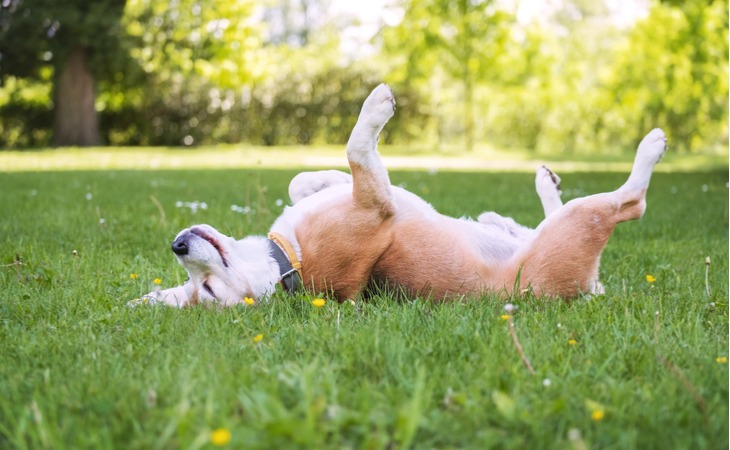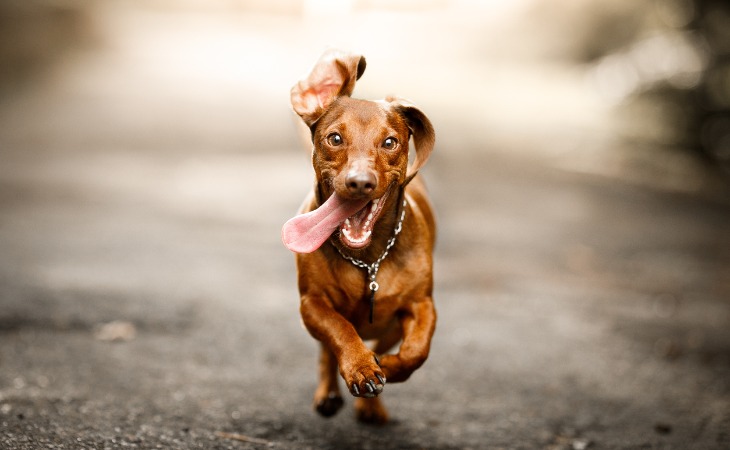There are many behavioral and physiological signs that can show whether or not your dog is happy. We will share a few of them here with you.
Behavioral signs that show your dog is happy
Your dog’s behavior and is the main indicator of his physical and mental health. It is a reflection of his happiness. If you want to understand how your pet is feeling, watch how your dog behaves.
Your dog wags his tail all the time
It’s always a good sign when your dog wags his tail. Dogs use their tails to communicate and signal their moods and intentions to those around them. For this reason, dogs who have had their tails cut off sometimes have problems with other dogs. A dog that wags his tail frantically from side to side is certainly a happy dog.
You might also like: Understanding your dog’s body language
Your dog is curious about everything you do
A dog’s happiness is directly related to the love he has to his owner. If your dog is comfortable and healthy, he will show great interest in the things that you do — even the simplest and most insignificant actions. For example, watching you cook or tie your shoes will spark his curiousity. He will come to observe and sniff your surroundings to stay close to you. This curiosity is a sign of happiness.
Your dog is searching for attention and cuddles
If your dog always wants to be close to you, it is a strong indication of his happiness and affection for you. A happy dog always seeks to be close to his owner, similar to how a child seeks that of their parents. If your dog lets himself be approached easily, comes on his own accord, and shows you his favorite places to scratch, you can be sure that he is happy. Similarly, some dogs will come and put their head on your lap while you are sitting. This is a sign of trust. He feels protected and shows it to you.
You might also like: How to pet a dog properly and Why does my dog lick me?
Your dog always wants to play
A happy dog is a dog that plays. The reverse is also true: a dog that plays is a happy dog. Just like children, playing is a wonderful way for dogs to learn and expend energy. A healthy dog will always be curious about anything that can be a game for him. Plastic balls, toys, and even slippers!
To keep your dog happy, take the time to play ball with him, walk him, and play with him. He will feel so loved.

Physiological signs that your dog is happy
Sometimes more discreet than behavioral signs, these physiological signs can tell you a lot about your dog’s happiness. However, if you have any doubts, always refer to a veterinarian.
Your dog has a good appetite
Your dog’s appetite is a very important physiological indicator that you should pay attention to. A happy dog eats regularly, with a good appetite. If he’s happy, he won’t pounce on food as if he were starving. If he does this, it could be indicative of poor health.
Your dog accidentally pees
Strong emotions can trigger the muscles of your dog’s bladder and make your dog wet himself. This emotion could be fear or great pleasure, for instance. If you dog pees for this reason, do not scold him. For example, if your dog is so happy to see you when you get home and shows you the new things he’s done before relieving himself on the floor, it’s not voluntary on his part, and it’s an obvious and uncontrollable sign of happiness for him.
However, if your dog has a recurrent or chronic inability to hold his bladder, you should consult a specialist. Apart from that, accidental peeing could just be a sign of your dog’s joy.
Your dog has bright eyes and dilated pupils
As Cicero said, the eyes are the window to the soul. Your dog’s eyes must be full of life. This means that his eyes should be bright and expressive. Similar to humans, a dog’s pupils dilate when he is happy or feels pleasure.
Your dog’s coat is shiny and healthy
Your dog’s happiness can show through his appearance as well. When dogs are healthy and happy, they have shiny coats, with strong and tight hair. Sadness, a lack of exercise or an unbalanced diet could affect a dog’s physical appearance.
Your dog sleeps well
When your dog has the right diet, exercise and affection, nothing should interfere with his sleep. He should be able to sleep between 12 and 14 hours a day. If your dog did a lot of physical activity, he could sleep even more. That being said, the amount of hours your dog sleeps may vary depending on his age and which breed he is. Restless sleep, on the other hand, can signify stress in your dog’s daily life.

